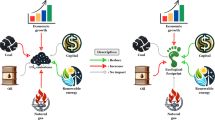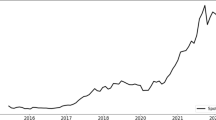Abstract
Sustainable consumption and production policies have been developed by the EU as part of the United Nations 10-year framework programme on sustainable consumption and production. In this context, the study of energy consumption and production patterns might be especially relevant as the importance of energy input. This paper develops the Sustainable Energy Market Aggregated Index in the EU-28 that provides information about the achieved effects of sustainable consumption and production policies on energy efficiency, energy dependence, generation mix based on clean production technologies and competitive market structure. The results suggest that Denmark, Sweden, UK, Italy, the Netherlands have the better scores. Reinforcing measures are proposed for member states with the lowest results (Slovakia, Luxembourg, Estonia, Czech Republic and Belgium) in order to move towards more competitive energy markets.

Source: Own elaboration

Source: Own elaboration

Source: Own elaboration
Similar content being viewed by others
Notes
Firstly, the calculation is made with equal to 12 and, secondly, with n equal to 5, in order to calculate the mean. Thus, a mean is obtained, in which the last years of the period have more weight.
The full liberalization of the electricity market in Cyprus was formally achieved on 1 January 2014 but it is still being implemented in practice.
The Polish Economy Ministry establishes a support scheme based on tendering in November 2013. However, this system bears an energy price risk for investors and tends to give advantages to large operators which might disfavour small investors (Ecologic Institute 2014).
References
Babcicky, P. (2012). Rethinking the foundations of sustainability measurement: The Limitations of the Environmental Sustainability Index (ESI). Social Indicators Research, 113, 133–157.
Bell, S., & Morse, S. (2005). Sustainability indicators: Measuring the immeasurable. London: Earthscan.
Bolcárová, P., & Kološta, S. (2015). Assessment of sustainable development in the EU 27 using aggregated SD index. Ecological Indicators, 48, 699–705.
Bond, A., Morrison-Saunders, A., & Pope, J. (2012). Sustainability assessment: The state of the art. Impact Assessment and Project Appraisal, 30, 53–62.
Büchner, J., Frenjen, R., Nikogosian, V., & Wolak, F. A. (2013). White paper on a sustainable design of the electricity market. Challenges from renewable energies and guidelines for a sustainable market design. Bonn: E-Bridge and UMS Group.
Büchner, J., & Frenken, R. (2013). Towards a sustainable market model (Why there is a need for a modified market model). Arnhem: Tennet.
Buclet, N., & Lazarevic, D. (2015). Principles for sustainability: The need to shift to a sustainable conventional regime. Environment, Development and Sustainability, 17(1), 83–100.
Caeiro, S., Ramos, T. B., & Huisingh, D. (2012). Procedures and criteria to develop and evaluate household sustainable consumption indicators. Journal of Cleaner Production, 27, 72–91.
Ciegis, R., Ramanauskiene, J., & Startiene, G. (2015). Theoretical reasoning of the use of indicators and indices for sustainable development assessment. Engineering Economics, 63(4), 33–40.
Commission, European. (2014a). Member State’s Energy Dependence: An Indicator-Based assessment. Ocassional Papers 196. Brussels: European Commission.
Commission, European. (2014b). EU Energy markets in 2014. Brussels: European Commission.
Council of the European Union. (2006a). Action plan for energy efficiency: Realising the potential COM/2006/0545 final. Brussels: European Commission.
Council of the European Union. (2006b). Review of the EU Sustainable Development Strategy (EU SDS)—Renewed Strategy. Brussels: European Commission.
Council of the European Union. (2010). Energy 2020: A strategy for competitive, sustainable and secure energy. COM(2010) 639. Brussels: European Commission.
Council of the European Union. (2011a). A resource-efficient Europe. COM (2011) 571 final. Brussels: European Commission.
Council of the European Union. (2011b). European Efficiency Plan. COM(2014) 0109. Brussels: European Commission.
Council of the European Union. (2014a). European Energy Security Strategy. COM(2014) 0330. Brussels: European Commission.
Council of the European Union. (2014b). Energy Roadmap 2050. COM(2011) 0885 final. Brussels: European Commission.
Council of the European Union. (2014c). A policy framework for climate and energy in the period from 2020 to 2030. COM(2014) 015 final. Brussels: European Commission.
Council of the European Union. (2014d). European Efficiency Communication. COM(2014) 520 final. Brussels: European Commission.
Council of the European Union. (2015). Redesigning the EU’s energy market. COM(2015) 240 final. Brussels: European Commission.
Dahl, A. L. (2012). Achievements and gaps in indicators for sustainability. Ecologic Indicators, 17, 14–19.
Eco-innovation Observatory. (2014). Eco-innovation in member states. Belgium: Eco-innovation Observatory.
Ecologic Institute. (2015). Assessment of climate change policies as part of the European semester. Berlin: Ecologic Institute.
European Commission. (2006). Directive 2006/32/EC of the European Parliament and of the Council of 5 April 2006 on energy end-use efficiency and energy services and repealing Council Directive 93/76/EE. Brussels: European Commission.
European Commission. (2009a). Directive 2009/28/EC of the European Parliament and of the Council of 23 April 2009 on the promotion of the use of energy from renewable sources and amending and subsequently repealing Directives 2001/77/EC and 2003/30/EC. Brussels: European Commission.
European Commission. (2009b). Directive 2009/72/EC of the European Parliament and of the Council of 13 July 2009 concerning common rules for the internal market in electricity and repealing Directive 2003/54/EC. Brussels: European Commission.
European Commission. (2009c). Directive 2009/73/EC of the European Parliament and of the Council of 13 July 2009 concerning common rules for the internal market in gas and repealing Directive 2003/54/EC. Brussels: European Commission.
European Commission. (2011). Eco-innovation Action Plan. Brussels: European Commission.
European Commission. (2015). Report from The Commission to the European Parliament and the Council Assessment of the progress made by member states towards the national energy efficiency targets for 2020 and towards the implementation of the Energy Efficiency Directive 2012/27/EU as required by Article 24 (3) of Energy Efficiency Directive 2012/27/EU. Brussels: European Commission.
European Environment Agency. (2011). Resource efficiency in Europe. Policies and approaches in 31 EEA member states and cooperating countries. Copenhagen: European Environment Agency.
European Environment Agency. (2015). The European environment state and Outlook 2015. Resource efficiency and the low-carbon economy. Copenhagen: European Environment Agency.
Evans, A., Strezov, V., & Evans, T. J. (2009). Assessment of sustainability indicators for renewable energy technologies. Renewable and Sustainable Energy Reviews, 13(5), 1082–1088.
Franco, A., & Salza, P. (2011). RETRACTED ARTICLE: Perspectives for the long-term penetration of new renewables in complex energy systems: the Italian scenario. Environment, Development and Sustainability, 13(2), 309–330.
Gibson, R. B. (2005). Sustainability assessment: Criteria and processes. London: Earthscan.
Goldrath, T., Ayalon, O., & Shechter, M. (2015). A combined sustainability index for electricity efficiency measures. Energy Policy, 86, 574–584.
Iddrisu, I., & Bhattacharyya, S. C. (2015). Sustainable Energy Development Index: A multi-dimensional indicator for measuring sustainable energy development. Renewable & Sustainable Energy Review, 50, 513–530.
Institute, Ecologic. (2014). Assessment of climate change policies in the context of the European Semester. Berlin: Ecologic Institute.
JRC. (2004). Dashboard of sustainability. http://esl.jrc.it/envind/dashbrds.htm. Accessed 4 May 2016.
Kocsis, V., & Hof, B. (2016). Energy policy evaluation in practice: The case of production subsidies and DEN-B in the Netherlands. Environment, Development and Sustainability, 18(5), 1433–1455.
Kumar, P., Ahmed, F., Singh, R. K., & Sinha, P. (2017). Determination of hierarchical relationships among sustainable development goals using interpretive structural modeling. Environment, Development and Sustainability. https://doi.org/10.1007/s10668-017-9981-1.
La Rovere, E. L., Soares, J. B., Oliveira, L. B., & Lauria, T. (2010). Sustainable expansion of electricity sector: Sustainability indicators as an instrument to support decision making. Renewable and Sustainable Energy Reviews, 14(1), 422–429.
Liobikienė, G., & Mandravickaitė, J. (2013). Convergence of new members of the EU: Changes in household consumption expenditure structure regarding environmental impact during the prosperous period. Environment, Development and Sustainability, 15(2), 407–427.
Loh, J. (Ed.). (2002). Living Planet Report 2002. Gland: World Wildlife Fund.
Mejía-Dugand, S., Hjelm, O., & Baas, L. (2017). Public utility companies in liberalized markets–The impact of management models on local and regional sustainability. Utilities Policy, 49, 137–144.
Observatory, Eco-innovation. (2015). Eco-innovation in member states. Belgium: Eco-innovation Observatory.
Odyssee. (2012). Energy efficiency in the EU—Country profiles and national reports. http://www.odyssee-indicators.org/publications/country_profiles.php. Accessed 3 October 2016.
OECD. (2008). Promoting sustainable consumption. Good practices in OECD countries. Paris: Organisation for Economic Cooperation and Development.
Pintér, L., Hardi, P., Martinuzzi, A., Hall, J., & Bellagio, P. (2012). STAMP: Principles for sustainability assessment and measurement. Ecologic Indicators, 17, 20–28.
Prescott-Allen, R. (2001). The wellbeing of nations. A country-by-country index of quality of life and the environment. Ottawa: Island Press.
Singh, R. K., Murty, H. R., Gupta, S. K., & Dikshit, A. K. (2012). An overview of sustainability assessment methodologies. Ecological Indicators, 15(1), 281–299.
Szulecki, K., Fischer, S., Gullberg, A. T., & Sartor, O. (2015). Giving shape to the energy union: Evolution, national expectations and implications for EU energy and climate governance. National expectations and implications for EU energy and climate governance (June 17, 2015).
United Nations. (2006). Sustainable consumption and production: Energy and industry. New York: United Nations.
United Nations. (2012). The future we want. United Nations Conference on Sustainable Development. Rio + 20.
United Nations Development Programme. (2008). Human development indices—A statistical update. New York: United Nations Development Programme.
United Nations Environment Programme. (2015). Sustainable consumption and production indicators for the future SDGs. New York: United Nations.
Waas, T., Hugé, J., Block, T., Wright, T., Benitez-Capistros, F., & Verbruggen, A. (2014). Sustainability assessment and indicators: Tools in a decision-making strategy for sustainable development. Sustainability, 6(9), 5512–5534.
Wackernagel, M., & Rees, W. (2007). Our ecological footprint—Reducing human impact on the earth. Gabriola Island: New Society Publishers.
World Economic Forum. (2002). Environmental sustainability index. An initiative of the global leaders of tomorrow environment task force. World Economic Forum, Annual Meeting.
Zaccaï, E. (2008). Assessing the role of consumers in sustainable product policies. Environment, Development and Sustainability, 10(1), 51–67.
Author information
Authors and Affiliations
Corresponding author
Rights and permissions
About this article
Cite this article
García-Álvarez, M.T., Soares, I. Empirical assessment of sustainable energy markets in the EU-28. Environ Dev Sustain 20 (Suppl 1), 83–108 (2018). https://doi.org/10.1007/s10668-018-0172-5
Received:
Accepted:
Published:
Issue Date:
DOI: https://doi.org/10.1007/s10668-018-0172-5




